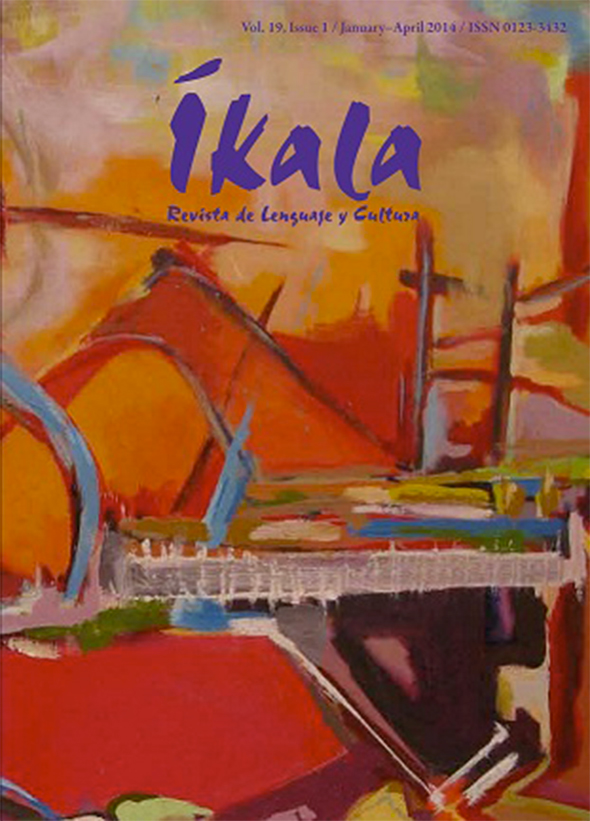Avaliação das denominadas características inflexionais marcadas do inglês nigeriano: um caso relacionado com a teoria da aquisição de uma segunda língua
DOI:
https://doi.org/10.17533/udea.ikala.14303Palavras-chave:
variantes do inglês, segunda língua, inflexões, interlínguaResumo
Existem posturas contrárias entre os estudiosos respeito de se as características estruturais dos tipos de inglês falados em países onde se utiliza como segunda língua dá-lhes o status de variante. Esta pesquisa analisa tais características morfológicas consideradas como marcadas no inglês que se fala na Nigéria tal e como o estabelece Kirpatrick (2011) e a variante do inglês que se fala na Malásia considerando os pressupostos da Hipótese de Inflexão Superficial Ausente (MSIH, por suas siglas em inglês), uma teoria de aquisição de segunda língua que dá conta da causa do uso variável de tais inflexões entre os aprendizes de L2. Resultados de tarefas de produção oral e escrita assignadas a estudantes de graduação de universidades na Nigéria e na Malásia mostram que as que se consideram características morfológicas são de fato desvios das formas da L2. Em concordância com a MSIH, a variabilidade de tais inflexões deve-se aos problemas de recuperação léxica, um problema psicolinguístico que se manifesta entre os aprendizes de inglês como L2, dando geralmente como resultado representações superficiais errôneas.
Downloads
Referências
Adegbija, E. (1989). Lexico-semantic variation in Nigerian English, World Englishes. Vol. 8, No.2, pp. 165-177.
Adetugbo, A. (1979). Appropriateness in Nigerian English & Nigerian English and communicative competence. In E. Ubahakwe (Ed.), Varieties and functions of English in Nigeria, pp. 137-165 & 167-183 respectively. Ibadan: African Universities Press.
Alo, M., & Mesthrie, R. (2008). Nigerian English: morphology and syntax. In R. Mesthrie, (Ed.), Varieties of English, Africa, South and Southeast
Asia, (pp. 323-339). Berlin: Mouton de Gruyter.
Bamiro, E. (1991). Nigerian Englishes in Nigerian English literature, World Englishes. Vol. 10, No. 1, pp. 7-17.
Bamiro, E. (1991). The social and functional power of Nigerian English, World Englishes. Vol. 10, No. 3, pp. 275-286.
Battistella, E. L. (1990). Markedness: The evaluative superstructure of language. Albany, NY: SUNY Press.
Chomsky, N. (1986). Knowledge of language: its origin, nature and use. New York, Praeger.
Geckin, V., & Hazenadar, B. (2008). The morphology/ syntax interface in child L2 acquisition: evidence from verbal morphology. Current trends in child second language acquisition: A generative perspective. In B, Haznedar & E. Gavruseva (Eds.), 237-270. Amsterdam: John Benjamins.
Gut, U., & Fuchs. R. (2013). Progressive aspect in Nigerian English. Journal of English linguistics 41(3), 243-276.
Hazenadar, B. (2007). The acquisition of tense-aspect in child language English. Second Language Research 23, (4) 383-417.
Haznedar, B., & Schwartz, B. (1997). Are there optional infinitives in child L2 acquisition? In Proceedings of the 21st annual Boston University conference on language development. In E. Hughs, & A. Greenhill (Eds.), 257-268. Sommerville, MA: Cascadilla Press.
Ionin, T., & Wexler, K. (2002). Why is 'is' easier than '-s'? Acquisition of tense/agreement morphology by child second language learners of English. Second Language Research, 18, 95-136.
Jakobson, R. (1984). Shifters, verbal categories and the Russian verb. Selected writings, Vol. 2: Word and Language, 130-147. The Hague: Mouton.
Kachru, B. (1987). The alchemy of English: The speed, functions and models of non-native Englishes, World Englishes. Vol. 8, No. 2, pp.239-241. Reviewed. by J. Fishman.
Kachru, B. (1992a). World Englishes. In Language Teaching. Cambridge: Cambridge University Press.
Kirkpatrick, A. (2011). World Englishes. In J. Simpson (Ed.), Handbook of Applied Linguistics. London: Routledge: 373-387.
Kujore, O. (1985). English usage: Some notable Nigerian variations. Ibadan: Evans Brothers Ltd.
Lardiere, D. (1998a). Case and tense in fossilized steady state grammar. Second Language Research, 14, 1-26.
Lardiere, D. (1998b). Dissociating syntax from morphology in a divergent L2 end-state grammar. Second Language Research, 14, 359-375.
McCarthy, C. L. (2007). Morphological variability in second language Spanish. PhD Dissertation. Department of Linguistics McGill University Montreal Canada.
Ogu, J. (1992). A Historical survey of English and the Nigerian situation. Lagos: Krafts Books Ltd.
Omar, A. (Ed.). (2004). The Encyclopedia of Malaysia: Languages & literature. (9 Vol.). Michigan: Archipelago Press.
Prevost, P., & White, L. (2000). Missing surface inflection or impairment in second language acquisition? Evidence from tense and agreement. Second Language Research, 16, 103-133.
Roslie, T., & Ting, Su Hie, (1994). Malaysian English: Exploring the possibility of standardization. Perttanika Journal of social science and humanities, Vol, 2, (1). 69-76.
Selinker, L. (1972). Interlanguage. International Review of Applied Linguistics, 10, 209-231.
Salami, A. (1968). Defining a standard Nigerian English. Journal of the Nigerian English Studies Association (2)1, 99-106.
Slabakova, R. (2009). What is easy and what is hard to acquire in a second language. In Proceedings of the 10th generative approaches to second language acquisition conference. In M. Bowles, T. Ionin, S.
Montrul, & A. Tremblay, (Eds.), 280-294. Somerville, MA: Cascadilla Proceedings Project.
Walsh, N. (1967). Distinguishing types and varieties of English in Nigeria. Journal of the Nigerian English Studies Association (2)2, 47-55.
White, L, (2003). Second language acquisition and universal grammar. Cambridge University Press.
Downloads
Publicado
Como Citar
Edição
Seção
Licença
Copyright (c) 2014 Íkala, Revista de Lenguaje y Cultura

Este trabalho está licenciado sob uma licença Creative Commons Attribution-NonCommercial-ShareAlike 4.0 International License.












